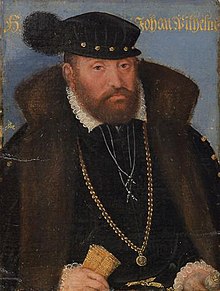Johann Wilhelm (Saxe-Weimar)
Johann Wilhelm I (born March 11, 1530 in Torgau , † March 2, 1573 in Weimar ) was the first Duke of Saxe-Weimar from the Ernestine Wettin family .
Life and Political Work
Johann Wilhelm was born as the second son of Duke Johann Friedrich I, the magnanimous of Saxony and his wife Sibylle von Jülich-Kleve-Berg . His father still held the title of Elector of Saxony, but lost it in 1547 after his defeat in the Schmalkaldic War . Johann Friedrich the Magnanimous therefore only bequeathed his sons the title of Duke of Saxony and an area that has been significantly reduced since the defeat and is limited to areas in what is now Thuringia . In 1554, after the death of his father, Johann Wilhelm I took over the government in this area, the Duchy of Saxony, together with his older brother, Johann Friedrich II., The middle one .
The two brothers ruled the duchy together, but agreed on a division of the country in 1565. The older brother received Saxe-Coburg and Eisenach and took up his residence in Gotha , Johann Wilhelm received Saxe-Weimar. The division plan also stipulated that the two brothers should swap their parts of the country with each other every three years. However, there was no longer such an exchange.
Through his policy, which was aimed at regaining the territories lost by his father in 1547 and the title of Elector, as well as through his involvement in the Grumbach trade , Johann Friedrich the Middle incurred the wrath of Emperor Maximilian II . The emperor finally imposed the imperial ban on him, the Elector of Saxony was the Reichsexekution commissioned at which also participated Johann Wilhelm. After a siege of his castle in Gotha, Johann Friedrich was finally defeated in 1567 and was imprisoned by the emperor until the end of his life. His possessions were confiscated by the emperor and handed over to Johann Wilhelm I, who thus became the sole ruler in the entire duchy of Saxony.
But Johann Wilhelm I also soon fell into imperial disfavor when he was appointed general for King Karl IX. of France in whose campaign against the Huguenots . This not only caused his Protestant subjects to shake their heads (a Wettin, whose dynasty had been the protector of Protestants in Germany since Frederick the Wise , allied himself with the Catholic King of France against the Huguenots who were denominationally close to the Lutherans), but also earned anger of the emperor, since the French kings were hereditary enemies of the Habsburgs .
The emperor therefore reinstated the two sons of the still imprisoned Johann Friedrich the Middle in their right of inheritance and, together with the Elector of Saxony, enforced the partition of Erfurt in 1572 . The Duchy of Saxony was divided into three parts. The older of the two sons Johann Friedrich the Middle, Johann Casimir received Saxe-Coburg , the younger Johann Ernst received Saxe-Eisenach , so only a small part of the country was left for Johann Wilhelm I, limited to Saxe-Weimar. Since this division there have always been several Ernestine dynasties in Thuringia side by side, so the entire Ernestine property (the Duchy of Saxony) was no longer united. The House of Saxony Weimar and the older House of Saxony-Altenburg , which later separated from Saxony-Weimar (see also Ernestine Duchies ), descended from Johann Wilhelm .
Johann Wilhelm could never get over this restriction of his territory; he died bitterly in Weimar only a year later.
family
Johann Wilhelm I was with Dorothea Susanna , a born Countess Palatine von Simmern, daughter of Friedrich III. married. He had four children with her. the future dukes
- Friedrich Wilhelm I (1562–1602) Duke of Saxe-Weimar
- Johann III. (1570–1605) Duke of Saxe-Weimar
and the daughters:
- Sibylla Maria (* November 7, 1563, † February 20, 1569)
- Maria (* October 7, 1571, † March 7, 1610). Abbess of Quedlinburg
literature
- Ernst Wülcker : Johann Wilhelm, Duke of Saxony . In: Allgemeine Deutsche Biographie (ADB). Volume 14, Duncker & Humblot, Leipzig 1881, pp. 343-350.
- Thomas Klein: Johann Wilhelm, Duke of Saxe-Weimar. In: New German Biography (NDB). Volume 10, Duncker & Humblot, Berlin 1974, ISBN 3-428-00191-5 , p. 530 f. ( Digitized version ).
- Daniel Gehren: Ernestine denominational politics. Confession formation, rule consolidation and dynastic identity establishment from the Augsburg Interim 1548 to the Concord Formula 1577, Leipzig 2011, esp. Pp. 287–435.
- Justus Lipsius: Oratio In funere illustrißimi principis ac Dn. D. Johannis Guilielmi Ducis Saxoniae Lantgravii Thuringiae, Marchionis Misniae, habita Ienae ad XII. Calend. April: Anno 1573 , no location 1601 ( digitized from ULB Saxony-Anhalt )
Web links
| predecessor | Office | successor |
|---|---|---|
| Johann Friedrich II. |
Duke of Saxony 1566 |
Division of the duchy |
| predecessor | Office | successor |
|---|---|---|
| emerged from the Duchy of Saxony |
Duke of Saxe-Weimar 1572–1573 |
Friedrich Wilhelm I. |
| personal data | |
|---|---|
| SURNAME | Johann Wilhelm |
| ALTERNATIVE NAMES | Johann Wilhelm I of Saxe-Weimar |
| BRIEF DESCRIPTION | Duke of Saxe-Weimar |
| DATE OF BIRTH | March 11, 1530 |
| PLACE OF BIRTH | Torgau |
| DATE OF DEATH | March 2, 1573 |
| Place of death | Weimar |

